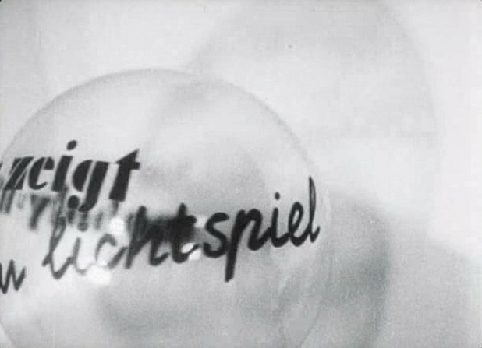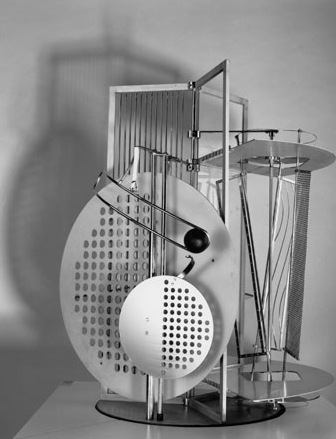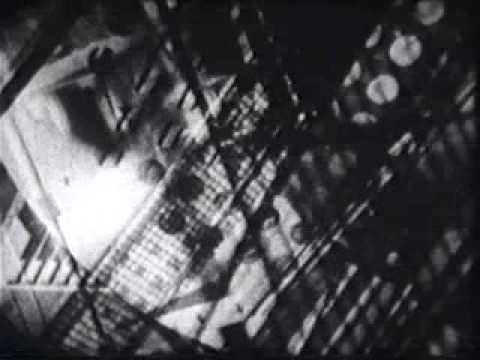from Cinegraphic.net:
Laszlo Moholy-Nagy: Abstracting from Reality
story © internetted, February 20, 2011 all rights reserved.
URL: https://www.cinegraphic.net/article.php?story=20110220075903772
An Excerpt from a current writing project-in-progress:
Laszlo Moholy-Nagy (1895 – 1946) spent an extended portion of his book Painting, Photography, Film concerned with issues of the “absolute film” following his initial observations about the importance of Viking Eggeling’s work. His focus was on the ability to create an abstract work where light and movement appear on screen separated from the confines of theatrical, literary cinema: he called these works light-space articulation; an idea he developed initially in the form of the Light-Space Modulator, a kinetic sculpture produced in collaboration with Stefan Seboek at the Bauhaus in Berlin. This work was in development for most of the 1920s, an on-going project of Moholy-Nagy’s from 1922 when he created the first version until his final version done in 1930. It is this last version that appears in Ein Lichtspiel schwarz weiss grau (1930).

Between 1929 and his death in 1946, Moholy-Nagy produced a number of films, but the majority of these are documentaries of work done at the Bauhaus or employ actors and a scenario; however, one of these films, Ein Lichtspiel schwarz weiss grau, is both a “documentary” and an abstract work independent of its subject. This film is significant, not for its development of sound-image relationships, but for the ways it employed the standard photographic technique and apparatus of the motion picture camera to create an apparently abstract film using physical materials and light—as reflection, distorted by prismic lenses, and as projections through an abstracting device; it is simultaneously an abstract film in itself and a documentary of the visual and optical phenomena produced by the Light-Space Modulator. Camera work and the framing of the shots in the film incorporated the movements of the reflectors, balls, and rods, and used the projected light patterns to create a singular visual composite, providing a bridge between the fully abstract work of the absolute animators Ruttmann, Eggeling, Richter and Fischinger and the motion photography of abstraction-generating and abstracted, yet physical, materials done by later abstract animators. This manipulation of physical material was an important innovative development from the initial experiments done in Ballet Mécanique by Leger and Murphy. If Moholy-Nagy’s Ein Lichtspiel schwarz weiss grau had been produced without reference to his sculpture, it would immediately be recognizable as being a fully abstract work; instead it is generally regarded as simply a documentation of his sculpture’s operation. There are several factors that suggest this documentary aspect is not the primary focus of the film: that the title does not reference the Light-Space Modulator, instead recalling Walther Ruttmann’s abstract films, Lichtspiel: Opus I – IIII; the organization of the visuals within the six minute running time; and the clear relationship between the film and Moholy-Nagy’s film theory.

The Light-Space Modulator offered the opportunity to visually demonstrate the potentials of cinema he described in 1924. The focus of this work is the translation of his ideas about visual form from sculpture to film. Because the subject matter of his film is already visually abstract, the motion pictures transferred those kinetic abstract forms to film, but with a series of key differences between what he produced and simple documentation of the machine’s operation. The images are framed in a careful, painterly fashion producing compositions—rather than documentary records—where it can be difficult to separate the moving elements from their reflections, shadows and projected patterns. His 1924 call for a new type of cinema, not concerned with representation could describe the result produced in 1930:
Film practice has so far been largely restricted to reproducing dramatic action without, however, fully utilizing the potentialities of the camera in an imaginatively creative manner. The camera as a technical instrument and the most important productive factor in film-making copies the world around us in a manner that is ‘true to nature’. We must be prepared for this; but we have hereto been too fully prepared, with the result that the important other elements in film-making have been insufficiently refined: formal tensions, penetration, chiaroscuro relationships, movement, tempo.
[Laszlo Moholy-Nagy, Painting Photography Film, translated by Janet Seligman(Cambridge: MIT Press, 1987) pp. 33-34.]
This collection of visual phenomena separated from dramatic narrative and conventional representational content—the abstract patterns of circles, projected light and simple geometric forms on view in Ein Lichtspiel schwarz weiss grau provides a moving analogue to the photograms and Constructivist paintings Moholy-Nagy was producing during the 1920s. Incorporating a mixture of positive, negative and superimposed images throughout its duration arranged into approximately fifteen distinct sequences, the development of the film is towards increasingly complex kinetic compositions of lines and planes.

Ein Lichtspiel schwarz weiss grau (1930) opens with a fast whirling ball that gradually slows enough to read “moholy=nagy zeigt ein lichtspiel” (moholy-nagy presents a lightshow). The title is followed by a shadow hands manipulating a film strip, then another shadow hand pulls title cards into place: “schwarz” (black card with white text), “weiss” (white card with black text), and “grau” (dark grey on lighter grey). The opening image of the film itself has a foreground-background instability: it is initially uncertain how to read the circular image: as a cut-out or as an object set against a field of softer grays. The ambiguity of visual space in this opening image provides one of the primary themes developed throughout the film. The opening sections present the visual motifs of the film: spatial ambiguity, the transformation of lines to planes, the confusion of shadows cast with the forms casting them, and the contrast of light to dark forms in motion using both positive and negative printing. These sequences develop their material singly, then in combination, to systematically confuse the relationship between what is a positive and what is a negative. Following these explorations are a series of sequences built around increasingly complex multiplications and superimpositions arranged and edited carefully to create the illusion of continuous movement.
Of particular interest are the sequences that use a prism to repeat and kaleidoscopically merge the movements on screen. As in the superimposed sequences that follow, the compositions and camera movements are designed to minimize the sense that what is shown is a rotating sculpture: imagery emerges out of the grey background and slides back into invisibility. As white circles are superimposed into these sequences, the distinctions between different shots begin to breakdown, hiding the edits even further.
At no point does Ein Lichtspiel give a coherent sense of what the animating sculpture actually looks like. This film is not a document of the device; it is a translation of the aesthetic animating that sculpture into a film, with a series of distinct, particular effects appearing in it that are only possible because Ein Lichtspiel is a film. The kinetic motion of the whole follows a circular, clockwise movement, with individual shots having been composed to emphasize the graphic, painterly dimensions of the image over the creation of a coherent, photographically real space. Much of the film’s images emphasize the chiaroscuro effects of light and dark—both through superimpositions and camera set-ups that enable light flares to reflect off the mirrors and glass surfaces within the Light Space Modulator. As the elements move, lines become planes and then abruptly vanish.
Moholy-Nagy has employed the sculpture as an abstract image generator, a tool for creating the kinds of flat, planar geometry that is so apparent in his paintings from c. 1930, when the film was produced. It presents a transfer of the geometric, Constructivist forms in his paintings that only imply movement to the apparent motion of cinema. Dwinnell Grant will attempt a similar translation of Constructivist geometry to film at the end of the 1930s using stop-motion animation and glass rods to create animated compositions.